OCRACOKE ISLAND – On the shelf of the china cabinet in Chester Lynn’s antique shop are three pewter plates that once belonged to Edward Teach, better known as Blackbeard the pirate.
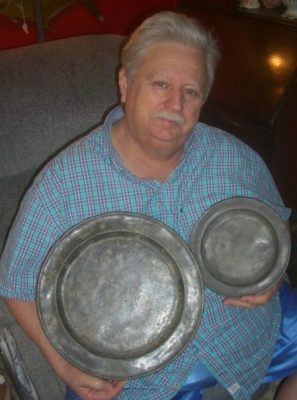
Lynn can trace his lineage back to two of the men who sailed with Blackbeard. One, Edward Salter, settled in Bath after his pirating days were over, and his descendents moved to Portsmouth Island. William Howard, who had been the quartermaster on Blackbeard’s ship, settled at Ocracoke.
Supporter Spotlight
Lynn, who was born in 1957, has roots both in Ocracoke and Portsmouth Island, and his life’s passion has been the history of these two islands. His head is full of historic stories and his house and antique shop are full of historic artifacts and antiques.
Fig trees have been a part of both islands histories, and they are a part of his life as well. He is presently writing a book about the figs of Ocracoke and Portsmouth.
The earliest record of Lynn’s ancestors on Portsmouth was the 1790 census, which listed Salvanius Dixon, his great-great-great-grandfather. His great-great-grandmother, Mary Salter, was, according to family lore, at her home in Portsmouth during the Civil War when the Yankees arrived. She hid her cow in the kitchen, which was in a separate building, and she threatened the soldiers, telling them that if they went into her kitchen she would “take a knife to them.” They left her kitchen and her cow alone.
Another family story was about Lynn’s great-great-grandmother, Emmaline Salter Dixon, also of Portsmouth, who had a fig tree so high that she would climb up on the roof to pick the figs.
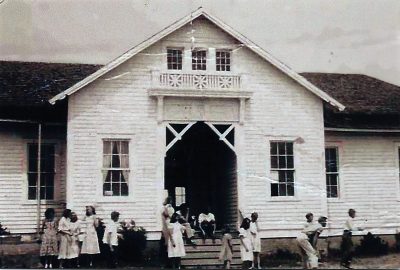
His great-grandmother, Helen Dixon, was living at Portsmouth when she met James Harvey “Hobby” Fulcher, who was from Ocracoke. They were married on Portsmouth Island in 1889 after which, according to the family Bible, eight boats were tied together in what was called a wedding chain and sailed back to Ocracoke in the dark of night. Hobby Fulcher built his bride a house on Ocracoke and before long Annabelle, Lynn’s grandmother, was born there.
Supporter Spotlight
Annabelle married a sea-loving island boy, George O’Neal. He told Lynn about a time in 1915 when the wealthy DuPont family sailed to Ocracoke on a huge yacht. They hired two local boys to crew on their trip back to Wilmington, Delaware. George O’Neal was one of the boys. Later he was the co-owner of Ocracoke’s famous mailboat, the Aleta, which in addition to mail, delivered merchandise, people, pigs, or anything else that needed to get to the island from Atlantic in Carteret County. He built a sailboat that he named for his wife, Annabelle and, according to Lynn, “he used to race it in many a race.” Years later, Lynn rebuilt the boat, which had fallen into disrepair, sailed it for a while, and sold it.
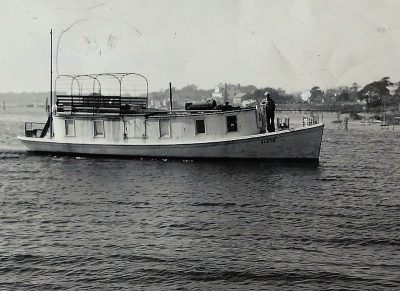
During World War II, when a Navy Base was built at Ocracoke, George O’Neal was the head of the dredge that pumped out the harbor for the Navy ships. He and Annabelle had a house near what are now the National Park Service docks. One day when Annbelle and her daughter Audrey Carol, 11 at the time, came home, they found their trees cut, their fence removed, and stacks of dynamite on their porch. Their house had been requisitioned by the Navy. They rebuilt next to the house where Lynn lives today.
When she was older, Audrey Carol, Lynn’s mother, fell in love with a Coast Guardsman who was stationed at the Hatteras Inlet Station. Lynn’s father was from Pennsylvania and Washington, D.C., but Lynn has never had any affinity to that side of his family. His “family” is all at Ocracoke, in his mind.
Lynn grew up in the same house on Ocracoke’s Back Road where he lives today, and where he markets antiques, floral arrangements and fig trees. The brightly painted sign at the side of the road says “Annabelle’s,” his grandmother’s name. While he has traveled extensively through his life, he has never lived anywhere else, nor wanted to.
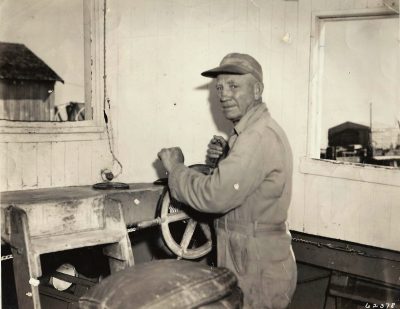
He has fond memories of growing up on Ocracoke. One is of playing the island version of hide-and-seek known as mehonky. “Whole sections of the island would play, and whoever got caught was put in prison. Girls and boys played, sometimes about 15, usually after dark.”
He and his sister spent much of their time at their grandma’s house next door. They used to love to play upstairs in two huge trunks, almost as big as caskets, which came off of one of the ships that wrecked on the shoals offshore.
Lynn also recalls playing at his Aunt Gertie’s, where there were lots of chickens running around in the yard. He liked to jump on the branches of the fig tree, trying to get the figs to fall on top of the chickens.
He has always liked chickens, he said, and over the years has had hundreds. They used to run free at his house before there were so many people nearby and on the road.
A less pleasant memory was a day when he was about 10 and attending the old school. Someone locked him in the bathroom and it took three or four hours for someone to find a hacksaw to cut him out. After that, he said, if he had to use the bathroom he ran home. Later he attended the new school where, he said, “it leaked so badly at first that the students sat in the lobby with beach umbrellas when it rained.”
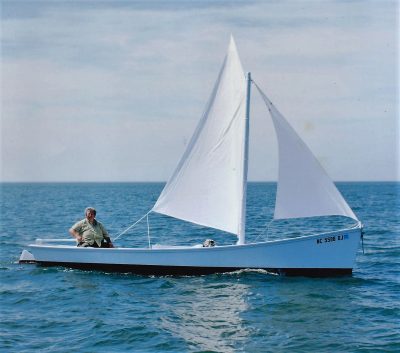
At the age of 10, Lynn began attending the Assembly of God Church, and he has attended ever since. One time, years later, he brought back two oleander seeds from Israel and planted them in the church yard, where they grow to this day.
He enjoyed visiting Liz Styron, the first cook at the Island Inn, and helped her with her chickens. He also enjoyed her cooking – stewed sea turtle, sailors’ hash and collards, among other things.” She used to wash our clothes on a washboard,” he recalled, “and later I bought her a washing machine. She was so excited you would have thought I’d bought her a Cadillac.”
Liz Styron told him the story of how, in the morning when the Storm of ‘44 started coming in, she had been working at the Pamlico Inn. They had to evacuate, and she had someone grab the stone steam-table crock that was used for making clam chowder and carry it to her house, so she’d be able to feed the people there. The inn was destroyed, and Lynn now has the crock, which Styron gave him.
Lynn has always had a fascination with antiques and with plants. He recalled that he grafted his first rose of Sharon before the age of 10. He could grow anything, he reminisces. His mother told him not to go near her clothespins, for she was afraid they would sprout.
While he does not have a formal education beyond high school and happily admits that he can’t spell worth a darn or speak what the school would call “good grammar,” Lynn is considered one of the island’s most knowledgeable historians. For one thing, he said, he has an almost photographic memory, and he has seen and heard about a lot of Ocracoke and Portsmouth history.
He managed the Island Inn for a number of years and later took care of Myra Wahab after her husband Stanley died. Stanley Wahab had, among other things, built the Wahab Village Hotel, now Blackbeard’s Lodge. In 2003 he opened his antique shop, Annabelle’s, on what was then known as Jack’s Dock in the Community Square. He later moved to his current location in the front rooms of his home on Back Road.

Figs have been a part of Lynn’s life for a long time, and a part of Ocracoke and Portsmouth history as well. The first mention of figs here was by John Grey Blount, who wrote of fig season in colonial records. Lynn has a 1911 picture of Henry Pigot and a fig tree on Portsmouth. He also has a picture of Lola Wahab’s fig tree taken in 1920 at Ocracoke. He remembers when there were three fig trees at Springer’s Point, Blackbeard’s former hangout, which is now protected by the Coastal Land Trust. One fig tree remains.
There are 15 species of fig trees on Ocracoke today, and fig preserves are some of the most sought-after items in gift shops and the grocery stores. For the past 10 or so years, Lynn has been rooting and selling fig trees, both to islanders and outsiders. He estimates that he sells 250 to 325 trees per year, and they end up all over the country. He participates in the Ocracoke Fig Festival, providing information and “helping to keep the facts straight.”
In recent months Lynn has embarked on a new undertaking. He is writing a book about all the fig trees at Ocracoke, old island fig recipes, the proper care of fig trees and fig-related stories about his life here. Island resident David Mickey has been working with him in compiling the stories, and Lynn has also had help from Trudy Austin and Sue Dayton.
Walt Wolfram, a distinguished professor at North Carolina State University, has been assisting Lynn with editing and publishing his book. Recipes include several from Miss Elma, such as her preserves, jam, dried figs and his grandmother Candice’s candied figs. He recalled helping her roll the figs in chocolate, cinnamon or whatever was in the ice box. There is also a recipe for pickled figs.
Lynn’s often serious face cracks into a grin when he tells this story. He wanted his figs to have some acclaim, so he persuaded a National Park Service friend to take two back to the nursery at the White House. He recently received a call saying that the trees, one a pound fig and one a sugar fig, are soon to be planted on the White House lawn. Lynn got a real kick out of that!







